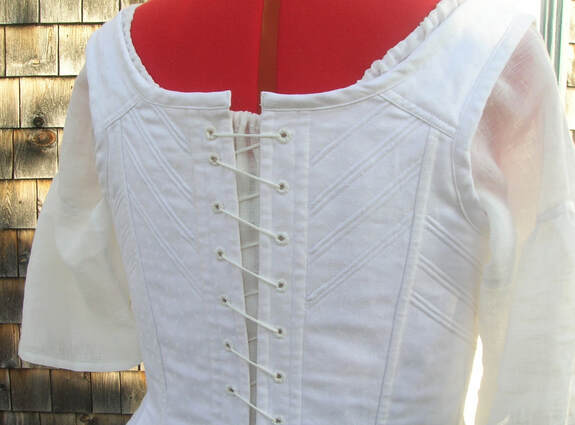|
As a maker of historical patterns, I'm the first to acknowledge the value of another maker's work if it's technically well-drafted (what I call "good pattern engineering"), reflects historical accuracy, and includes clear and complete instructions. So I'm not averse to turning to a fellow pattern-maker in a pinch, in order to avoid having to reinvent the wheel and/or go from zero to 90 to create a garment from an historical period with which I'm largely unfamiliar (not to mention with a short deadline looming). Now, I'm not going to go so far as to advertise another maker's pattern here on my own website, but please read on -- I'm perfectly willing to tell you whose pattern I made use of!
0 Comments
Examples of silk stays bound with silk taffeta bias. 18th Century stays are so beautiful, and actually fairly straightforward to make (at least in my view, compared to Edwardian corsets). But everybody seems to dislike the binding process, and I can't say that I don't understand the complaint. Either it seems the end result looks untidy, the binding itself is difficult to work with, or the procedure is hard on the hands. Yet I think there are ways to make the process less disagreeable and the result more attractive. First, I have to say that in looking carefully at a number of extant stays of the 18th C., the binding was not always smooth and perfect. If its purpose was mainly to seal the raw edges and prevent fraying, and only secondarily to look beautiful, then I think you can justify a less than perfect binding on historical grounds. So relax a little, but consider the following alternatives. First, I firmly believe that for modern reproduction stays, a bias binding is easiest to work with, and available in many colours. It is also, in my view, more beautiful than leather binding (unless your purpose is to accurately reproduce historical stays that would only have been bound in leather/chamois). Bias binding presents two main options: purchased bias binding or self-made binding. Personally I prefer the latter. On silk or fine woollen or linen stays, closely-woven silk taffeta, cut into strips about 3.5cm (around 1-1/4") wide is beautiful, easy to work with, and tough enough to withstand a lot of normal wear. On linen or fine wool stays, self-fabric binding (in a contrasting colour) is a good option as well, although the linen binding will need to be closely-woven to work well. The problem with purchased bias binding is that it tends to be made of polyester (or a poly/cotton blend). This fact alone rules it out for use as binding in my view, because it will be much less workable than a natural fabric that has good resilience, spring, and flexibility to go around tight corners and edges. My favourite choice then for the type of stays I make is silk taffeta bias. It can be machine-stitched on, but I honestly find that the process of machine-sewing binding onto the closely-spaced and deeply-cut tabs of 18thC. stays is so fussy and requires so much twisting and turning of the work and contortions of the hands, that it's not much faster than hand-applying the binding. So I hand-apply my silk taffeta bias binding, using a very short back-stitch. Whether the binding has its inner edge pressed in order to finish that edge neatly on the inside of already-lined stays, or whether the raw inner edge is just turned to the wrong side and loosely tacked on before the lining is applied, the same application process can be used as shown in the short video below (the link will take you to the video on my Facebook page). I've found that this method minimizes undue bunching at the inner points, and gives a smooth appearance to the finished tabs. The silk bias is also quite lovely on its own merits as an embellishment, and of course can be had in almost any colour. Although those of us who have worn 18th century stays are familiar with the usual way these are spiral-laced, there can be a problem with stays that are back-laced only, if no one else is around to act as a helper or dresser. I personally prefer back-lacing stays for their smooth, firm and comfortable solid fronts. But getting spiral lacing done up properly and firmly on one's own in back-lacing stays can either require a feat of contortionism or a valiant surrender to a less-than-ideal silhouette. Some time ago, mostly out of necessity because my "helper" husband was having an almost excruciating time: (a) trying to understand the physics of spiral lacing; and (b) trying to actually do up the lacing effectively, I devised a bit of a cheating lacing system -- what some might call an 18th century lacing "hack". |
AuthorPatricia Preston ('The Fashion Archaeologist'), Linguist, historian, translator, pattern-maker, former museum professional, and lover of all things costume history. Categories
All
Timeline
March 2024
|








 RSS Feed
RSS Feed